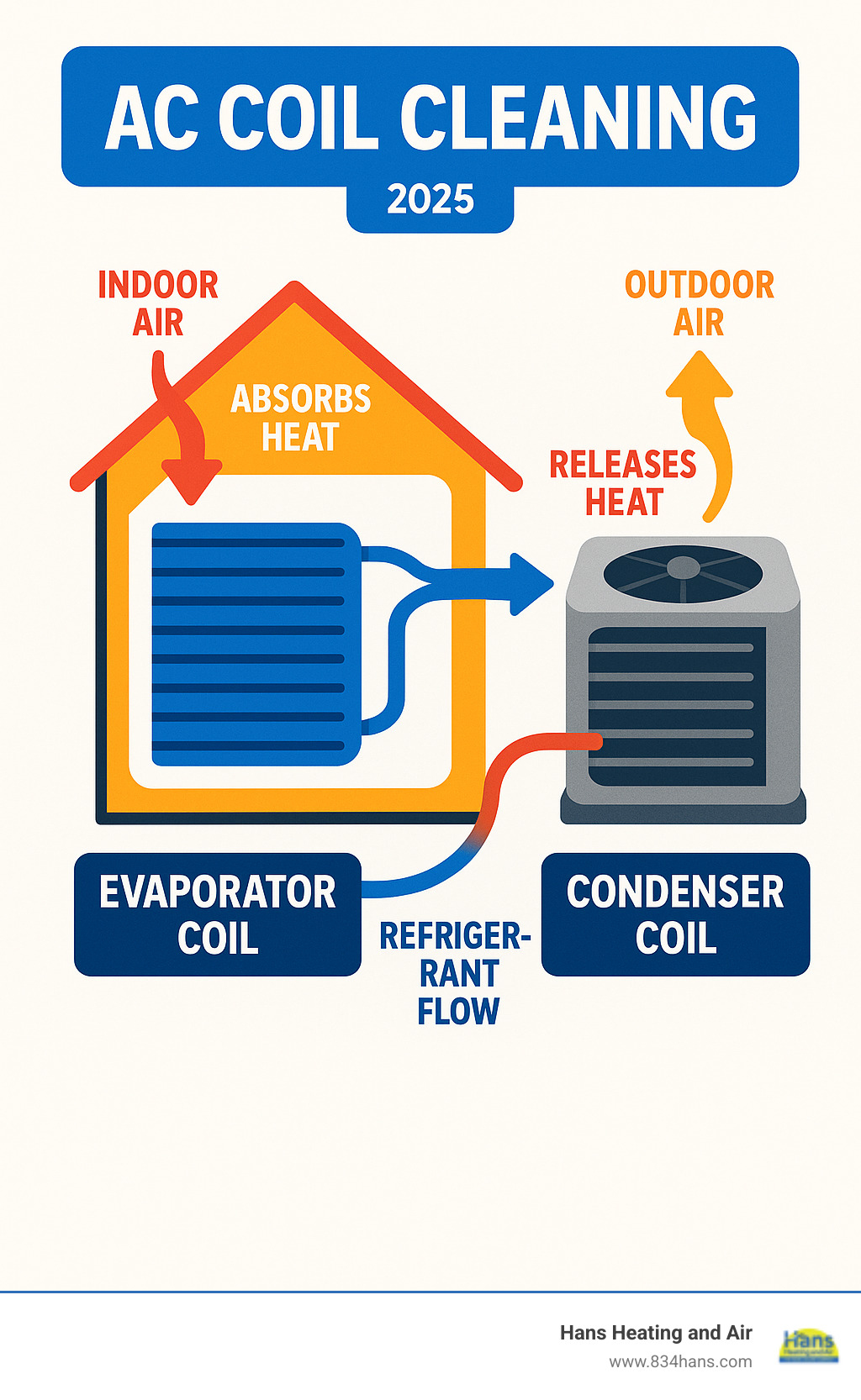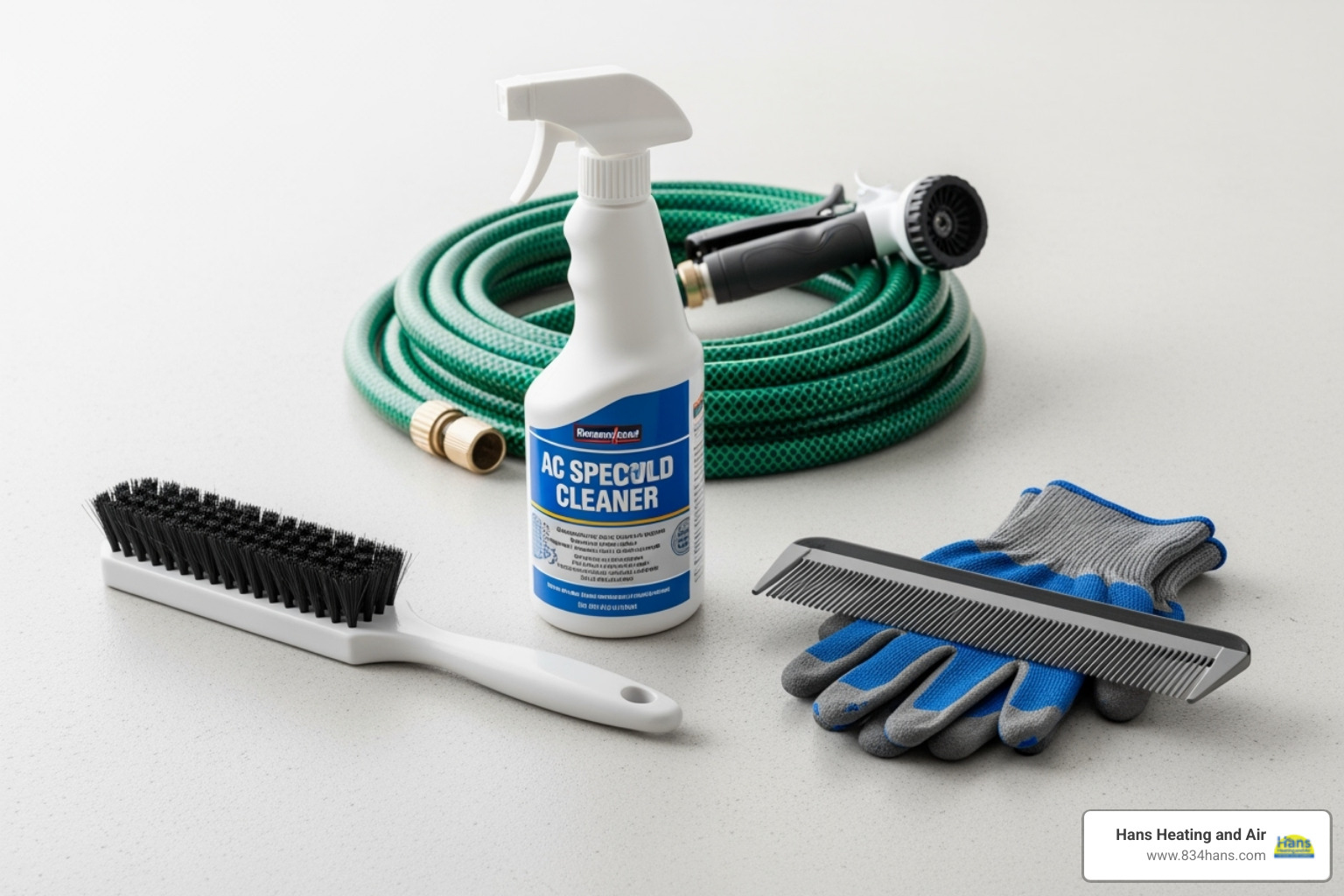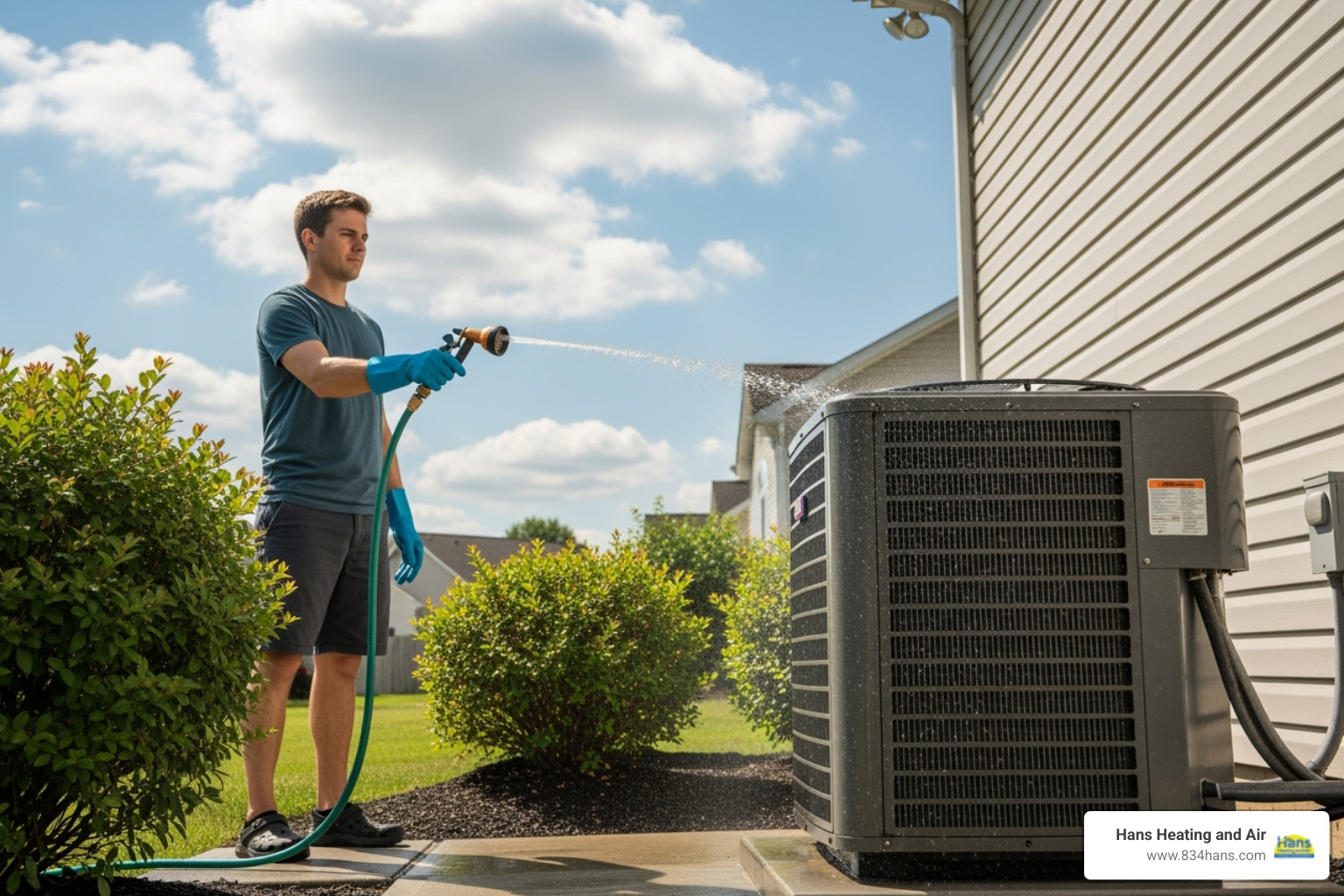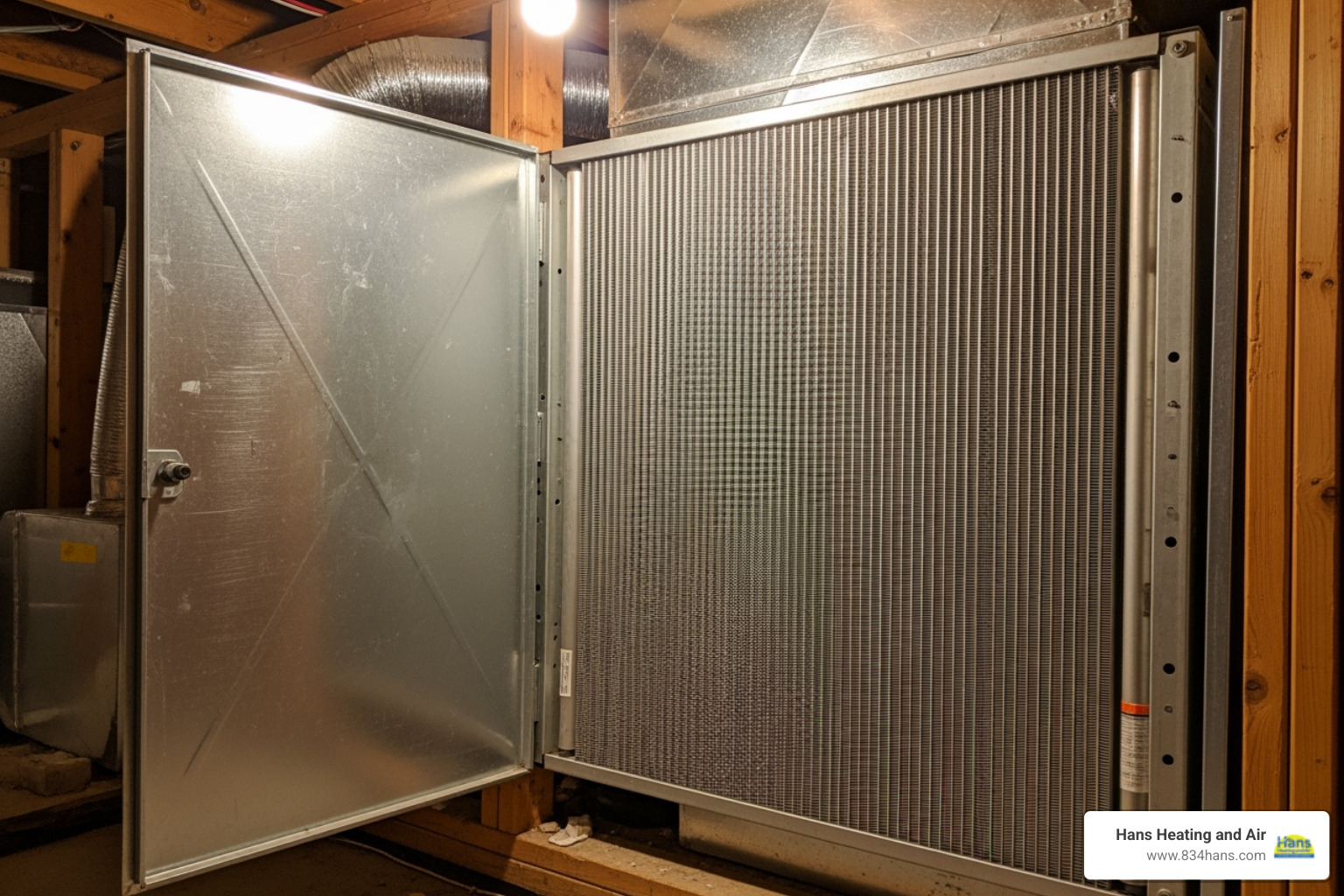Don't Sweat It: Easy Steps to Clean Your AC Coils
Why Your AC Coils Need Some Love
AC coil cleaning is one of the most important maintenance tasks you can do to keep your air conditioner running efficiently. When your coils get dirty, your system works harder, uses more energy, and may even break down completely.
Quick Answer for AC Coil Cleaning:
- Turn off power at the breaker box
- Clean outdoor coils - Remove debris, spray cleaner, rinse gently
- Clean indoor coils - Use no-rinse cleaner on evaporator coils
- Straighten fins with a fin comb if needed
- Check annually or when you notice reduced cooling
Your AC has two main coils that work together to cool your home. The evaporator coil inside absorbs heat from your indoor air, while the condenser coil outside releases that heat. When these coils get clogged with dirt, dust, and debris, they can't do their job properly.
Dirty coils can reduce your AC's efficiency by up to 60% - meaning you're paying a lot more for a lot less cooling. Even worse, dirty coils force your system to work overtime, which can lead to expensive repairs or complete system failure.
The good news? Cleaning your AC coils is something many homeowners can handle themselves with the right tools and knowledge. You'll save money on energy bills, extend your system's life, and keep your home comfortable all summer long.

Why Clean Coils are a Cool Idea
When your AC coils get clogged with dirt and grime, it's like the system is trying to breathe through a thick wool sweater. If it can't "breathe" properly, its performance suffers.
Dirty coils are efficiency killers. They act as an insulating blanket, blocking the heat exchange that keeps your home cool. Your system has to work overtime, causing efficiency to drop by up to 60%.
This efficiency loss hits your wallet hard, as your energy bills climb. What used to cost $150 a month might jump to $240 or more during peak summer.
This strain also puts extra stress on the compressor—the heart of your AC system. This can lead to overheating, premature wear, and potential failure, which is an expensive repair.
There's another problem many homeowners don't think about: air quality. Dirty coils become magnets for dust, pollen, and pet dander. Even worse, the damp environment around your evaporator coil is a perfect breeding ground for mold and bacteria. These contaminants get blown into your living space, causing musty smells and potentially triggering allergies or respiratory issues.
What Are AC Coils and Where to Find Them
Your air conditioning system has two hardworking coils that make the magic happen. Think of them as the lungs of your AC – they need to stay clean to keep everything running smoothly.
The evaporator coil lives inside your home, usually tucked away in your air handler or above your furnace. This indoor coil is made of copper tubing wrapped with thin aluminum fins. Its job is to absorb heat from the warm air in your house. As refrigerant flows through the coil, it soaks up that heat and transforms from liquid to gas, cooling the air that gets circulated back through your home.
The condenser coil sits outside in that big unit in your yard. It's also made of copper tubing with aluminum fins, though some newer units use all-aluminum construction. This outdoor coil does the opposite job – it releases all that absorbed heat into the outside air. The hot refrigerant gas from inside your house comes here to cool down and turn back into liquid before heading inside again.
These coils work as a team in the heat exchange process. The thin aluminum fins on both coils maximize surface area, making heat transfer more efficient. But those same fins, with their tight spacing, are also perfect traps for dirt, leaves, grass clippings, and anything else floating around in the air.
Signs It's Time for a Clean
Your AC system is pretty good at sending distress signals when its coils need attention. Learning to recognize these signs can save you from bigger problems down the road.
The first sign is often reduced cooling. If your home isn't getting as cool as it used to, dirty coils are a likely culprit because they can't transfer heat effectively.
Higher utility bills are another dead giveaway. If your bills are climbing without a change in your habits, your AC is likely working harder due to dirty coils.
Look for unusual running patterns. Your AC might start short-cycling (turning on and off frequently) or run constantly as it struggles to cool your home.
Ice formation on your indoor coil is a serious red flag. Restricted airflow from dirt can cause moisture to freeze on the coil, worsening the problem and potentially damaging your system.
Musty odors from your vents often signal mold or mildew growth on the dark, damp surfaces of a dirty coil.
Finally, use your eyes. Visible dirt and debris on the outdoor unit's fins or decreased airflow from your vents are clear signs that AC coil cleaning is overdue.
Here are the key warning signs your coils need cleaning:
- Your home stays warmer despite the AC running constantly
- Energy bills spike without explanation
- Ice forms on indoor coils or refrigerant lines
- Musty smells come from air vents
- Outdoor coil fins look caked with dirt
- Weak airflow from registers throughout your home
- AC cycles on and off too frequently
Catching these signs early and scheduling regular ac coil cleaning can prevent costly repairs and keep your system running efficiently for years to come.
Your Step-by-Step Guide to AC Coil Cleaning
Ready to give your AC coils the TLC they deserve? Before you start, remember: safety first. Your AC system uses electricity, so always begin by turning off the power at the breaker box and your thermostat. A few extra minutes of safety prep is always worth it.
While we at Hans Heating and Air offer professional maintenance, many handy homeowners can tackle ac coil cleaning themselves. With the right tools and patience, you can get great results. This guide will walk you through the care and cleaning of air conditioning coils to keep your system running smoothly.
The process is straightforward. You're essentially giving your AC's most important parts a good cleaning. The outdoor condenser coil needs to be cleared of outdoor grime, while the indoor evaporator coil needs to be freed of dust and particles from your home's air. Both jobs are doable with some basic supplies and our step-by-step approach.
Essential Supplies for AC Coil Cleaning
Just like any home project, having the right tools makes all the difference between a smooth job and a frustrating afternoon. Here's what you'll want to gather before starting your ac coil cleaning trip:

Your shopping list should include a coil cleaning spray specifically designed for HVAC systems – avoid household cleaners that can damage delicate components. A fin comb is your secret weapon for straightening those bent aluminum fins that restrict airflow. You'll need basic screwdrivers or nut drivers to remove access panels, plus a shop vacuum for sucking up loose debris.
Don't forget the basics: protective gloves and safety glasses to keep you safe from dirt and chemicals. A garden hose with a gentle spray nozzle is essential for rinsing outdoor coils – but absolutely no pressure washers! They'll destroy those delicate fins faster than you can say "expensive repair." A soft brush or cloth helps with gentle cleaning, and some HVAC tape might be needed if you have to remove existing tape to access panels.
One pro tip: grab a white towel to use when cleaning evaporator coils. You'll be amazed at how much dirt comes off, and seeing it on the white cloth gives you a real sense of accomplishment!
How to Clean Outdoor Condenser Coils
Your outdoor condenser unit is like the hardest worker in your home's cooling team, and it shows. Between pollen, grass clippings, leaves, and general outdoor grime, these coils take a real beating. The good news? They're usually the easier of the two coils to clean since you have better access and can rinse them thoroughly.

Start by disconnecting the power – we can't stress this enough! Once that's done, clear away any large debris like leaves or twigs from around and inside the unit. Your hands or a shop vacuum work great for this. Think of it as giving your AC some breathing room.
Next, remove the outer case if possible. Most units have screws holding the top and side panels in place. Take your time here and be gentle with the fan wires when lifting the top panel. With better access to the coils, you can clean from the inside out, which is way more effective than trying to push dirt deeper into the unit.
Use your shop vacuum to remove loose dirt, then grab your fin comb to straighten any bent fins you find. These little aluminum fins are delicate but important for airflow. Now comes the satisfying part: apply your coil cleaner generously, following the product instructions. Let it sit and work its magic for about 5-10 minutes.
The final step is rinsing thoroughly with your garden hose. Here's the key: rinse from the inside out if you've removed the panels. This pushes dirt away from the coil instead of deeper into it. Keep rinsing until the water runs clear, then let everything air dry before reassembling and restoring power.
How to Clean Indoor Evaporator Coils
Indoor evaporator coils might not face the outdoor elements, but they're dealing with dust, pet hair, and all the particles floating around your home. Plus, they're in a dark, damp environment that mold absolutely loves. The tricky part? They're usually tucked away in tight spaces and can't be rinsed like outdoor coils.

After disconnecting the power (yes, again!), you'll need to locate and access the coil. It's typically in the plenum right above your furnace or air handler. Look for an access panel that might be insulated – your owner's manual can be a lifesaver here if you're not sure where to look.
Once you have access, inspect the coil and clear any debris with a soft brush attachment on your shop vac. Be extra gentle here – these fins are even more delicate than the outdoor ones. Don't forget to clean the drain pan below the coil, which can harbor mold and bacteria. A damp cloth with mild detergent works well, and you might want to flush the drain line with a cup of water mixed with a tablespoon of bleach.
For the actual coil cleaning, use a no-rinse coil cleaner. These are specifically designed for indoor coils where rinsing isn't practical. The foam expands, breaks down the dirt, then collapses and drips harmlessly into the drain pan. It's pretty clever stuff! Let the cleaner work for the recommended time, then carefully reassemble everything and restore power.
The whole process might feel a bit cramped and awkward, but your reward is cleaner air and a more efficient system. Plus, you'll sleep better knowing you're not breathing air that's passed over a moldy coil!
DIY vs. Professional Cleaning: Making the Right Choice
Now comes the big question: should you tackle ac coil cleaning yourself, or call in the pros? It's a decision many homeowners face, and honestly, there's no one-size-fits-all answer. Your comfort level, the condition of your system, and the potential risks all play a part in making the right choice.
DIY coil cleaning can save you money upfront and give you that satisfying feeling of maintaining your own home. But it's not without its pitfalls. On the flip side, professional cleaning costs more but brings expertise and peace of mind. The key is understanding what you're getting into with each option.
The Risks of Improper DIY Cleaning
DIY cleaning has risks if you're not careful. The delicate aluminum fins on the coils are fragile; too much pressure can bend them, restricting airflow more than the original dirt.
Refrigerant leaks are another serious concern. Puncturing the copper tubes that contain pressurized refrigerant creates an expensive and environmentally harmful mess that requires professional repair.
There's also electrical danger. Forgetting to turn off the power or spraying water on electrical components can cause dangerous shorts or fry control boards.
Using the wrong chemicals is another common mistake. Harsh degreasers not designed for HVAC use can corrode the coils, leading to premature failure and costly repairs.
When to Call a Professional
Sometimes the smart money is on calling Hans Heating and Air. If your coils look like they haven't been cleaned since the Clinton administration, with deeply impacted dirt that's practically cemented on, professional-grade equipment and cleaners might be your only hope.
Suspected refrigerant leaks are definitely professional territory. If you're hearing hissing sounds, noticing poor cooling, or seeing unusual ice buildup, don't mess around – these are signs that need expert diagnosis.
Electrical issues should always be left to licensed technicians. If you're uncomfortable working around electrical components, or if you suspect any wiring problems, it's not worth the risk to your safety or your wallet.
Extensive mold growth is another red flag. While you can handle minor mold with proper cleaners, widespread contamination might require specialized sanitization techniques to ensure it doesn't come back with a vengeance.
And honestly, if you're just not confident in your abilities, there's no shame in calling the pros. Your AC system is a significant investment, and sometimes the peace of mind is worth the service fee.
For annual maintenance, we always recommend professional service. Our technicians don't just clean coils – we perform comprehensive system checks, identify potential problems early, and ensure everything is running at peak efficiency.
Here's how the two options stack up:
| Feature | DIY Coil Cleaning | Professional Coil Cleaning |
|---|---|---|
| Cost | Low (supplies only) | Higher (service fee) |
| Time | 1-2 hours per unit | Usually under an hour per coil |
| Safety | Potential risks present | High safety standards |
| Effectiveness | Good for routine cleaning | Superior for deep cleaning |
| Tools | Basic household tools | Specialized professional equipment |
| Knowledge | Requires careful research | Expert HVAC system knowledge |
When Cleaning Isn't Enough: Coil Replacement
Sometimes, no amount of scrubbing will bring your coils back to life. Just like everything else in your home, coils have a lifespan and can suffer damage that makes replacement the smarter choice than cleaning.
Severe corrosion is often the death knell for coils. When you see widespread rust eating away at the metal, it's usually just a matter of time before leaks develop. At that point, you're fighting a losing battle.
Multiple refrigerant leaks are another sign that replacement makes more sense than repair. We can patch one leak, but when they start popping up like whack-a-moles, you're better off investing in a new coil rather than playing an expensive game of leak roulette.
Significant physical damage beyond bent fins – like crushed sections, punctures, or severe impact damage – often can't be repaired effectively. The coil might technically still work, but its efficiency will be compromised permanently.
The age of your unit plays a big role in this decision too. If your AC system is pushing 10-15 years old and needs a major coil replacement, it might make more financial sense to replace the entire unit. New systems are more efficient, come with warranties, and won't leave you wondering what component will fail next.
We'll always give you honest advice about whether cleaning, repair, or replacement is your best bet. Sometimes the hardest truth is that throwing good money after bad isn't the answer, and investing in a new, efficient system will serve you better in the long run.
Frequently Asked Questions about AC Coil Cleaning
We get a lot of questions about ac coil cleaning from homeowners in Montgomery and throughout Central Alabama. Here are the most common ones – along with the honest answers you need to keep your system running smoothly.
How often should I clean my AC coils?
The golden rule is at least once a year, preferably in spring before the summer heat kicks in. Think of it like getting a physical – you might feel fine, but regular checkups catch problems before they become expensive headaches.
That said, your cleaning schedule might need some tweaking based on what's happening around your home. If you live somewhere dusty or near a busy road, your outdoor condenser coils are going to collect grime faster than usual. Got pets that shed like it's their full-time job? Those furry tumbleweeds will find their way to your coils too.
Here's something that catches a lot of folks off guard: cottonwood trees. If you've got these beauties in your yard, their fluffy white seeds can absolutely clog up your condenser coils in no time. We've seen units that look like they're wearing winter coats in the middle of summer!
Even if you're diligent about DIY cleaning, we still recommend having a professional maintenance check annually. Our technicians have the tools and experience to spot issues you might miss, plus we can give your system the kind of deep clean that keeps it running like new.
Can I use a pressure washer on my AC coils?
No way, no how! We can't say this loud enough – pressure washers and AC coils do not mix. We know it's tempting when you see how gunky those outdoor coils can get, but resist that urge.
Those delicate aluminum fins on your coils are about as sturdy as aluminum foil. High-pressure water will bend and flatten them faster than you can say "expensive repair." Once those fins are damaged, airflow gets restricted, your system loses efficiency, and you might even end up with bigger problems like the coil freezing up.
The pressure can also damage the coil tubing itself, potentially causing refrigerant leaks that require professional repair. Trust us – the few minutes you might save with a pressure washer aren't worth the risk of costly damage.
Stick with a regular garden hose and a gentle spray nozzle. Low pressure is all you need to rinse away dirt and cleaning solution effectively. Your coils (and your wallet) will thank you.
Does cleaning AC coils really save money?
Absolutely, and the savings are more significant than most people realize. When we tell homeowners that dirty coils can reduce efficiency by up to 60%, they're often shocked. But it's true – and that directly hits your monthly energy bills.
Here's how clean coils put money back in your pocket. Improved efficiency means your AC doesn't have to work overtime to cool your home. It reaches your desired temperature faster and maintains it more easily, which translates to lower energy consumption every single month.
But the real savings come from avoiding major repairs. When your system isn't straining against dirty coils, there's much less wear and tear on expensive components like the compressor and fan motor. Preventing air conditioning breakdowns is always cheaper than fixing them after they happen.
We've seen too many situations where a simple coil cleaning could have prevented a costly compressor failure or major system breakdown. Regular maintenance like ac coil cleaning extends your system's lifespan, delays the need for replacement, and keeps those surprise repair bills at bay.
Think of it this way – spending a little on maintenance now saves you a lot on repairs and energy costs later. It's one of the smartest investments you can make in your home's comfort.
Keep Your Cool with Regular Maintenance
When it comes to AC coil cleaning and maintenance, think of it like brushing your teeth – a little effort regularly prevents big problems later. We've covered a lot of ground together, from identifying dirty coils to rolling up your sleeves and cleaning them yourself. The bottom line? Clean coils are the secret to a happy, efficient air conditioning system.
The benefits we've discussed aren't just nice-to-haves – they're game-changers for your home comfort and wallet. Improved efficiency means your AC doesn't have to work overtime just to keep you cool. A longer system lifespan means you won't be shopping for a new unit anytime soon. Better air quality keeps your family breathing easy, and lower costs keep more money in your pocket where it belongs.
Here's the thing about DIY maintenance: it's fantastic for routine upkeep, but knowing your limits is just as important as knowing how to clean those coils. Sometimes the smartest move is calling in the professionals, especially when you're dealing with stubborn grime, potential electrical issues, or when you'd rather spend your weekend doing something more fun than wrestling with your HVAC system.
That's where we come in. At Hans Heating and Air, we've been keeping homes throughout Montgomery, Hope Hull, Lake Martin, Millbrook, Pike Road, Prattville, Wetumpka, and all of Central Alabama comfortable for years. Our expert technicians don't just clean coils – we provide comprehensive care that catches small problems before they become big headaches.
We believe in honest, straightforward service that puts your comfort first. Whether you need a thorough coil cleaning, annual maintenance, or help with a repair, we're here with the expertise and friendly service you deserve.
Ready to give your AC the professional attention it deserves? Don't wait until the heat of summer puts extra stress on dirty coils. Schedule your professional AC maintenance in Montgomery, AL with us today, and let's keep your home cool and comfortable all season long!
Other Services
Community Involvement

























